Effects of organic fertilizer and HB101 plant vitalizer on the growth and yield of rice (Oryza sativa L.)
To study the effects of organic fertilizer and HB101 organic plant
vitalizer on the growth and yield components of the BH9 rice
variety, a field experiment with 4 x 3 factorial design was conducted
at Hong Thai commune, Kien Xuong district, Thai Binh province in
2017 summer season using a randomized complete block design
with 3 replications. Organic fertilizer derived from chicken manure
and peat was applied at 3 levels (0 ton ha-1, 4 tons ha-1, and 6 tons
ha-1) while the HB101 plant vitalizer was sprayed in 4 levels (0%,
0.015%, 0.025%, and 0.035%; the amount of water to dilute HB101
was 1000 litre ha-1). The application of the organic fertilizer alone
and the combination of organic fertilizer and HB101 positively
increased the total tiller number, effective tiller number, leaf area
index (LAI), SPAD value, dry matter accumulation, yield
components, and grain yield of rice. There were also differences in
the SPAD values (at flowering stage), dry matter weight (at active
tillering stage), and 1000 grain weight under the influence of the
HB101 solution. The combination of 6 tons ha-1 organic fertilizer
and HB101 significantly increased the grain yield as compared to
the other treatments, and the highest grain yield (3.03 tons ha-1) was
obtained when organic fertilizer (6 tons ha-1) was applied in
combination with HB101 plant vitalizer (0.025%).
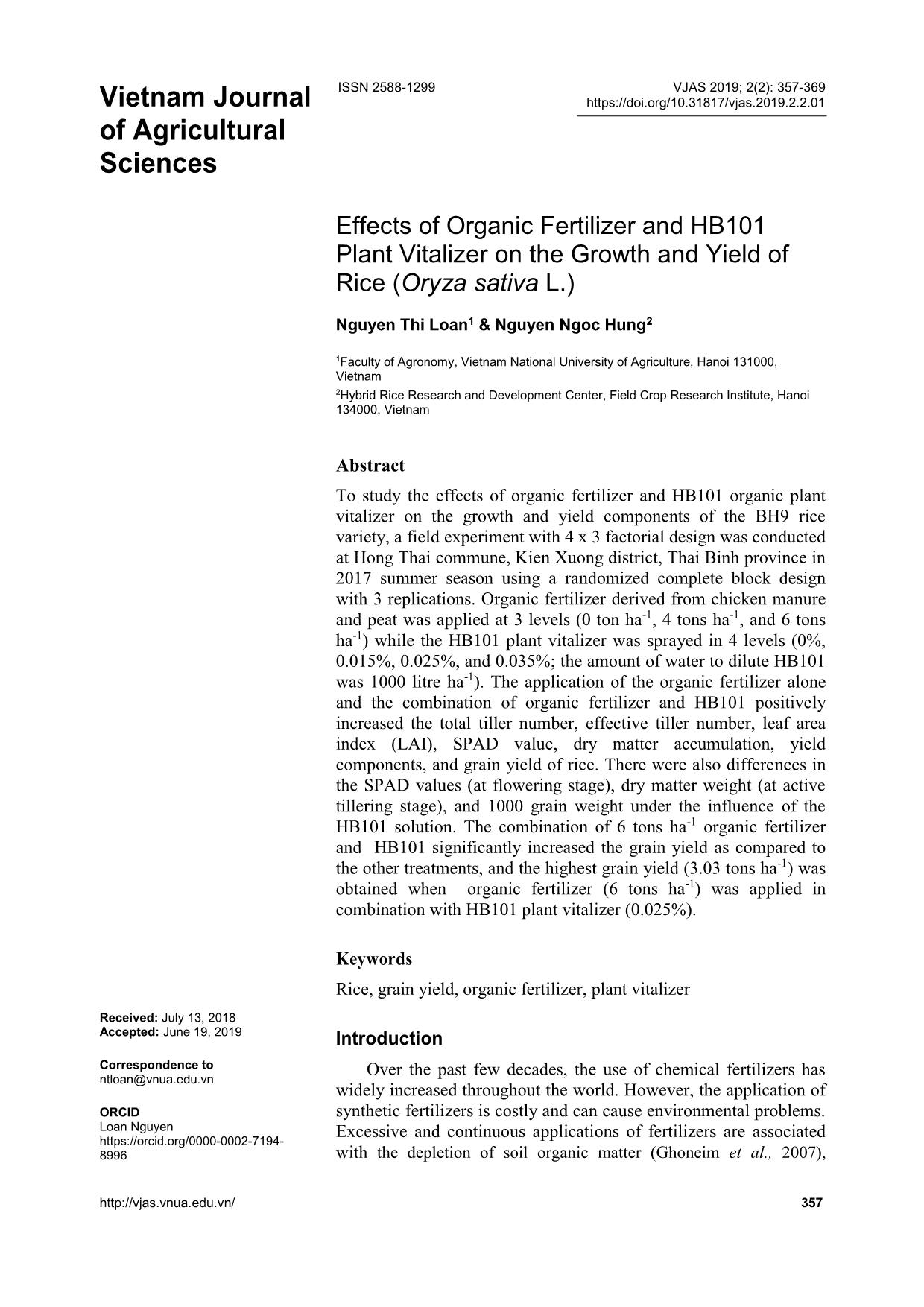
Trang 1
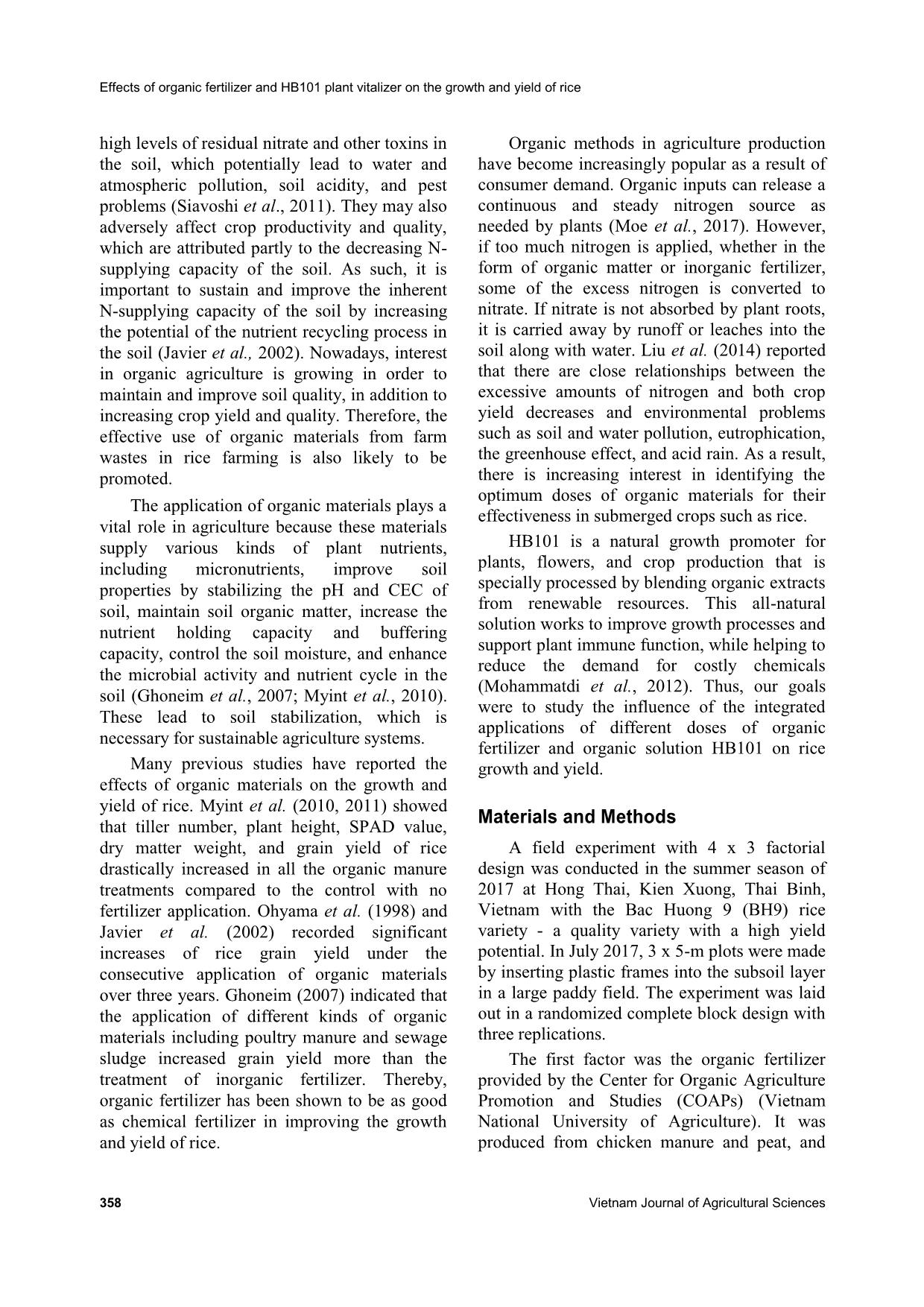
Trang 2
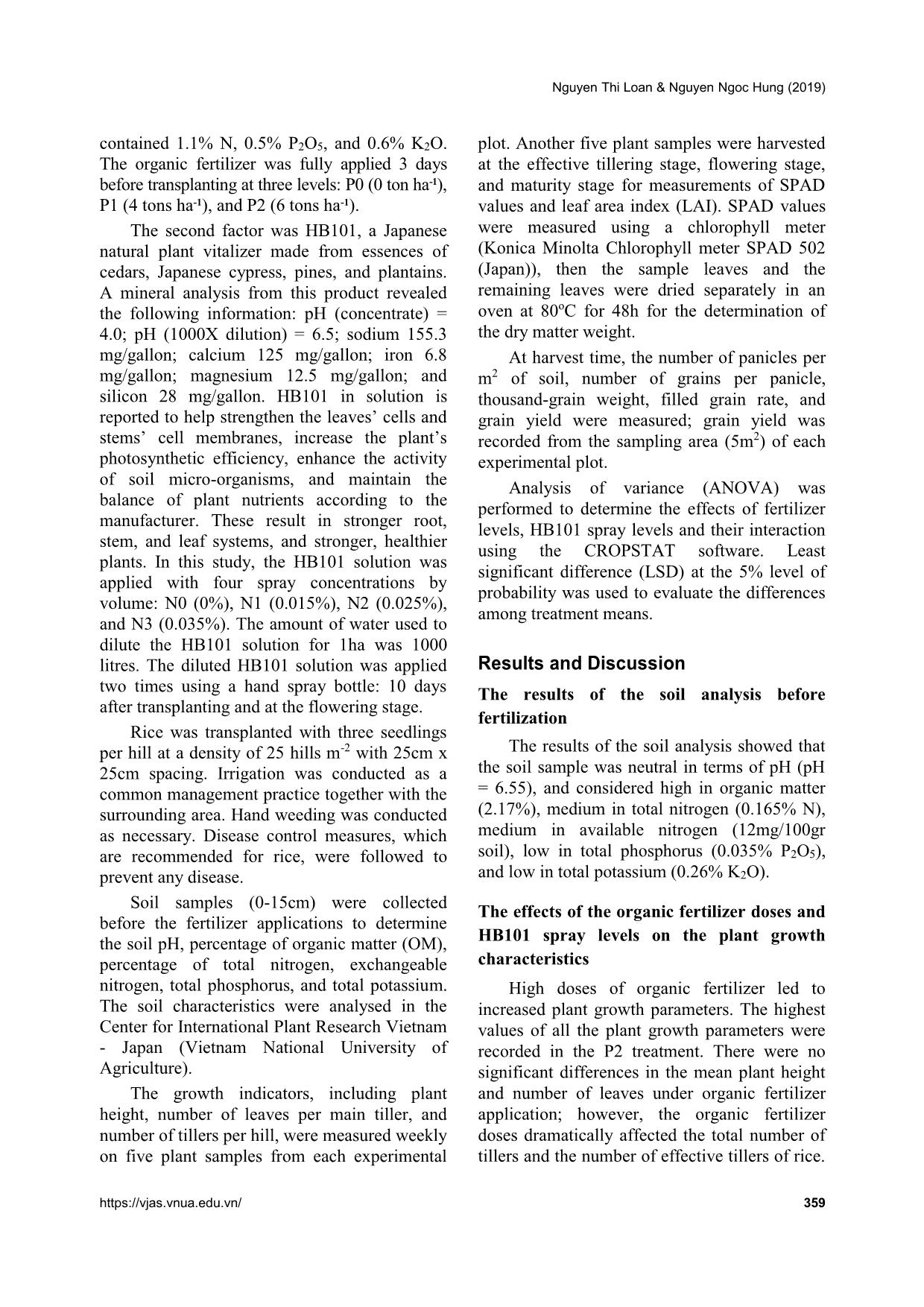
Trang 3
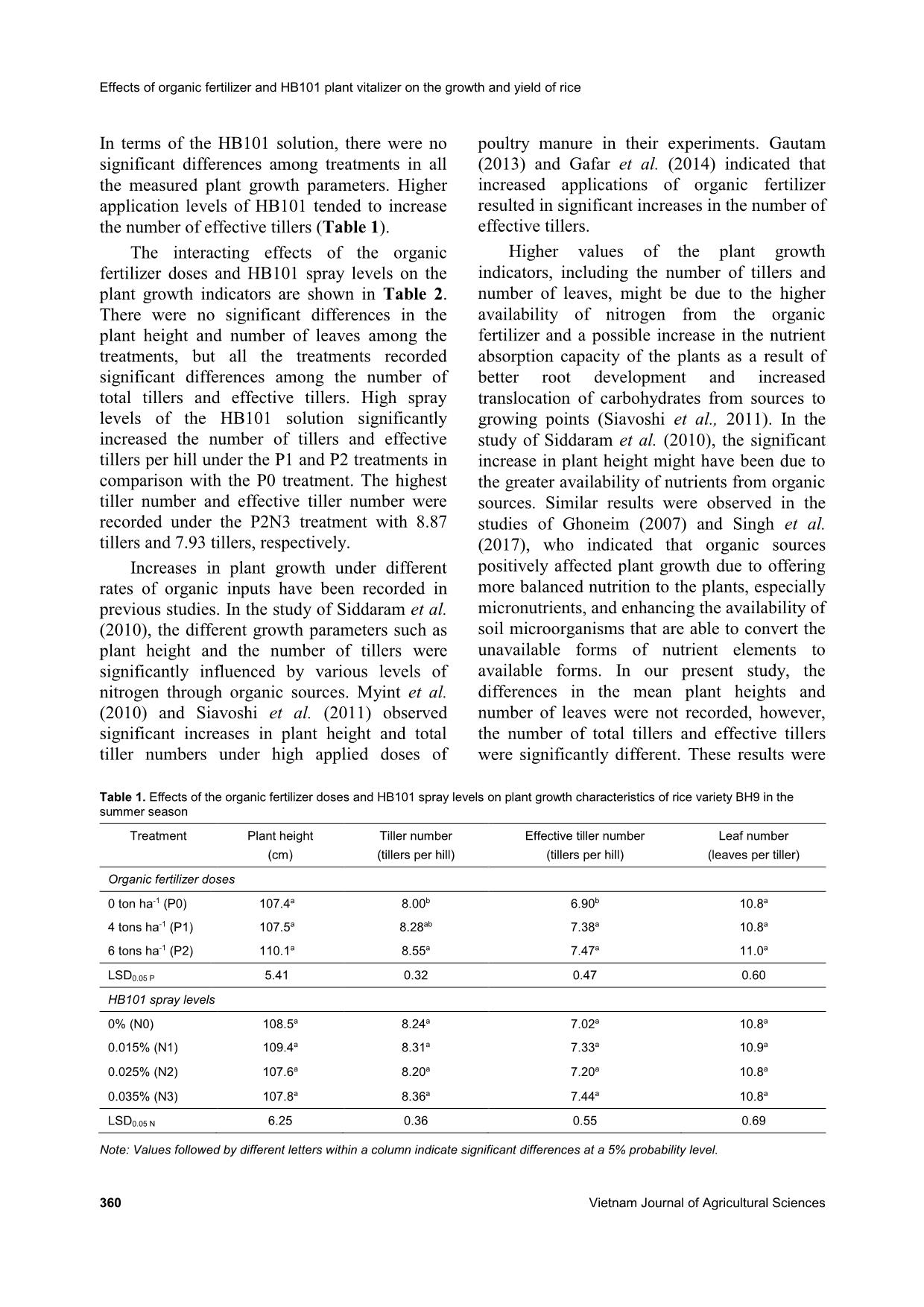
Trang 4
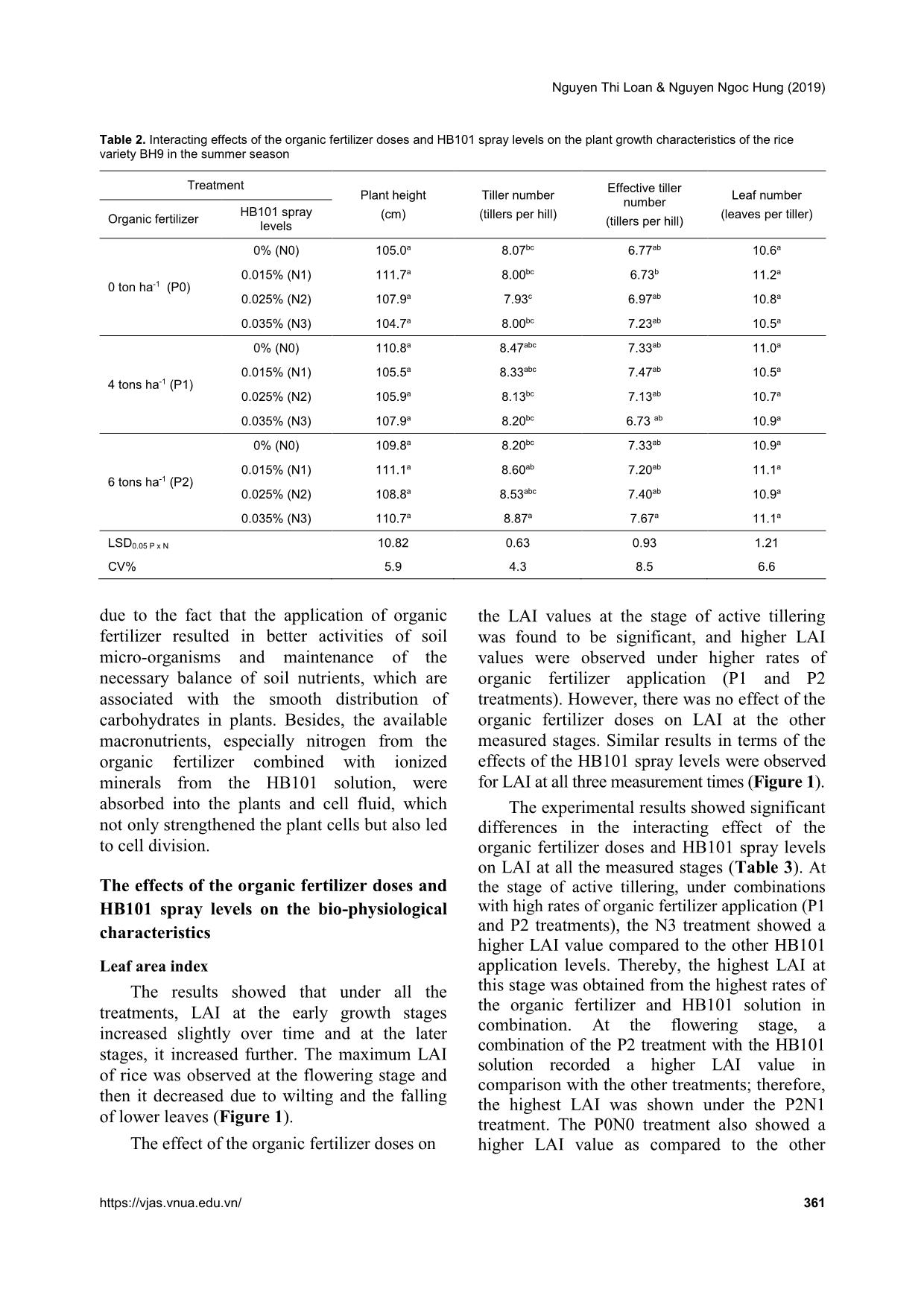
Trang 5
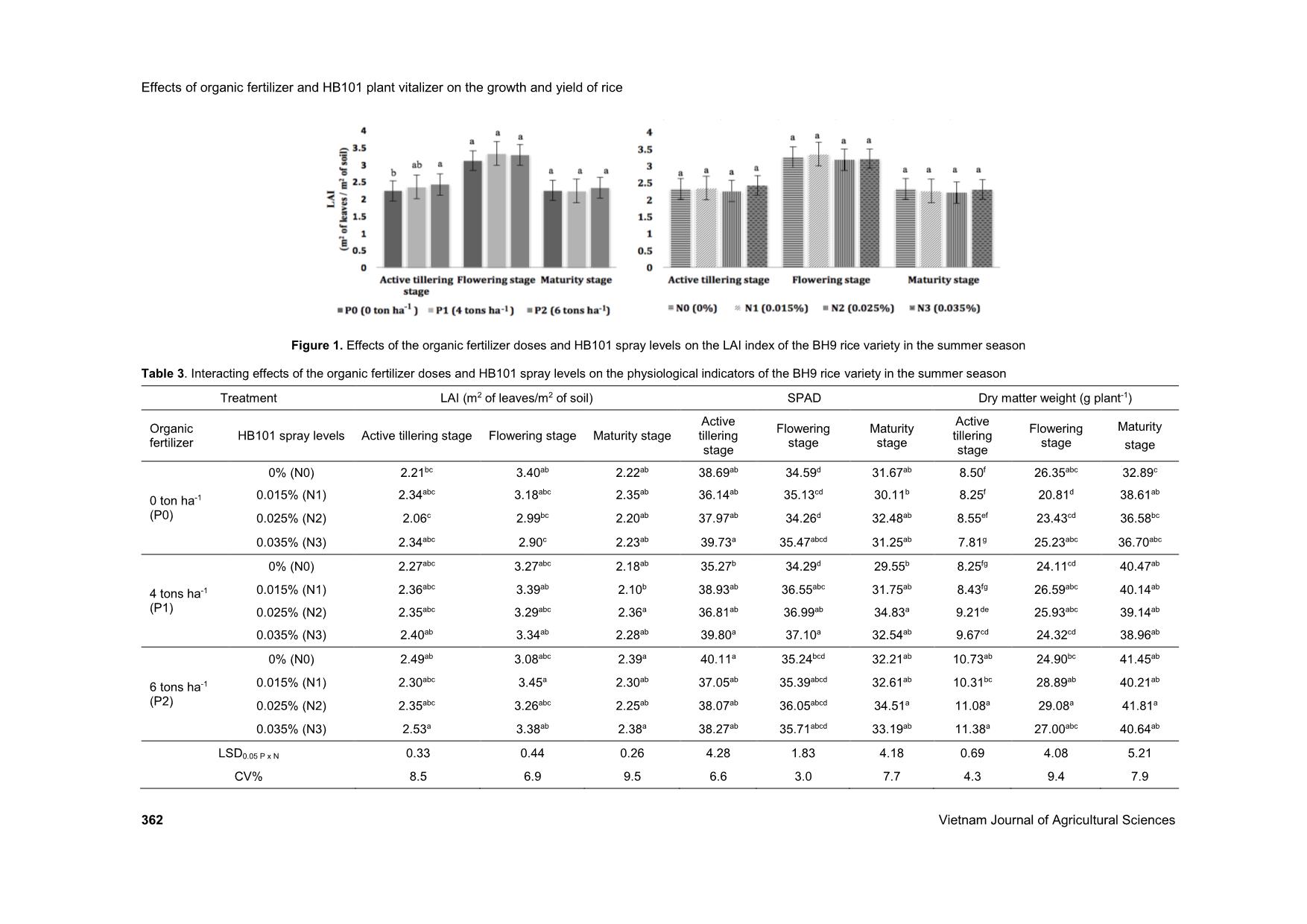
Trang 6
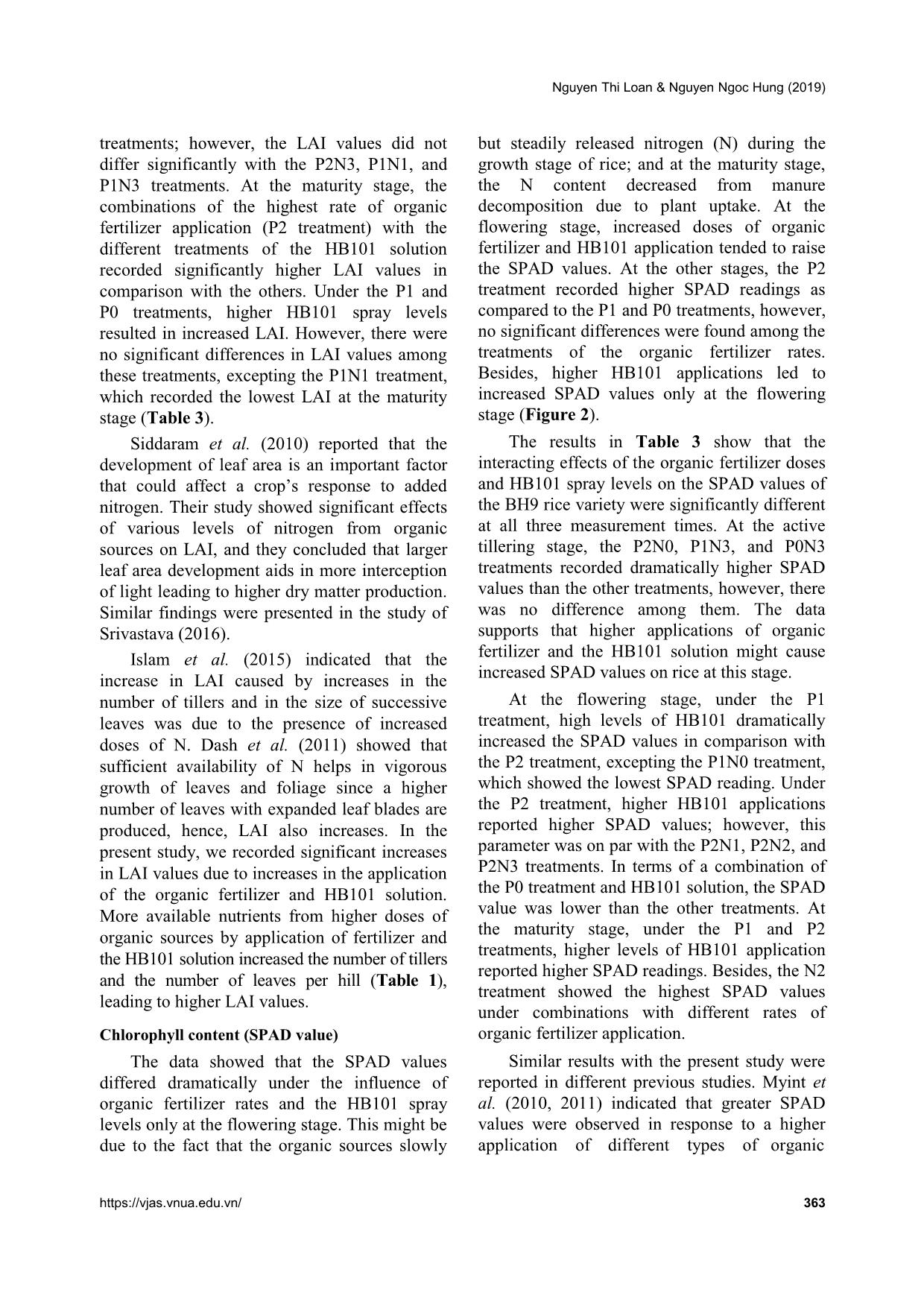
Trang 7
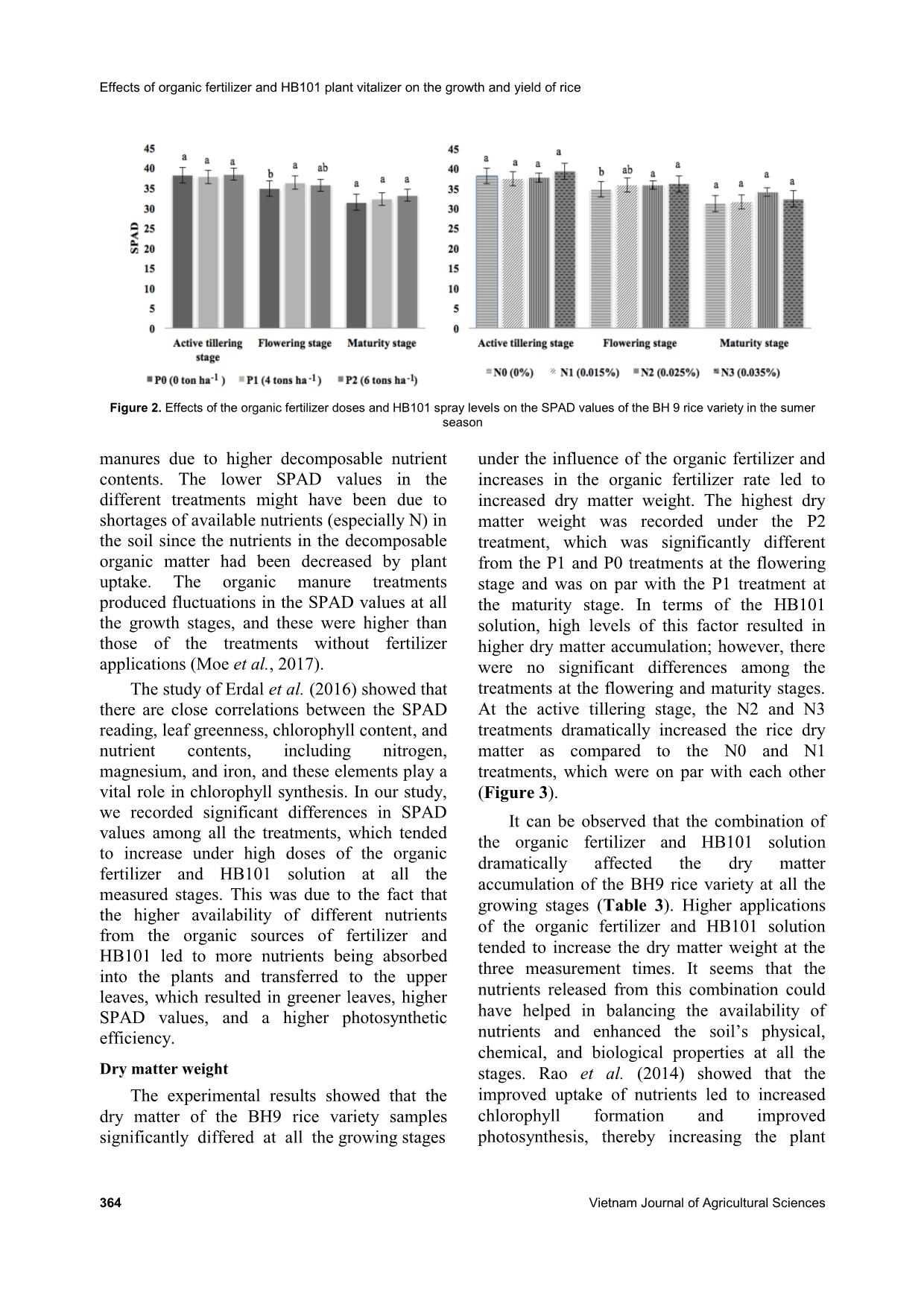
Trang 8
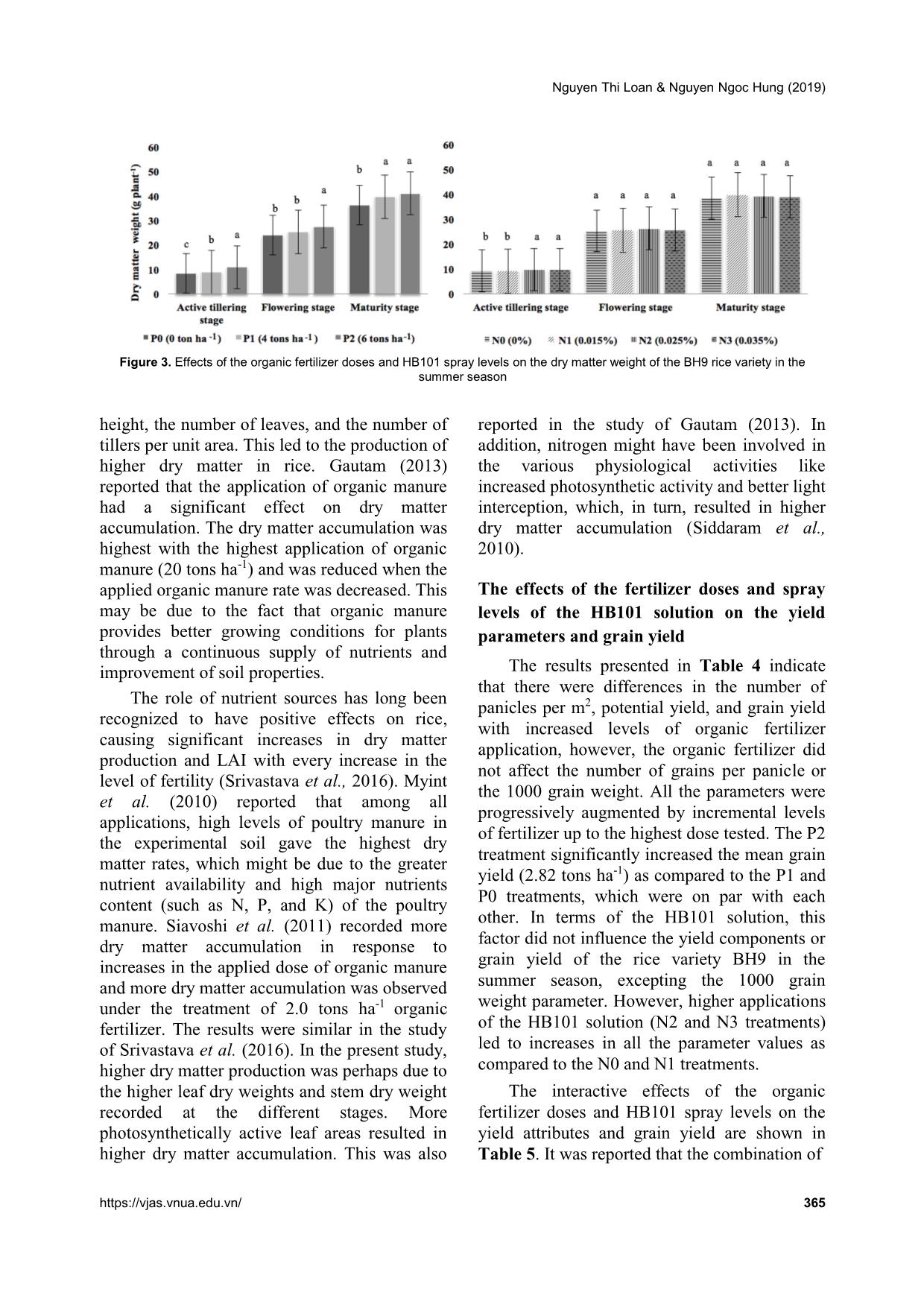
Trang 9
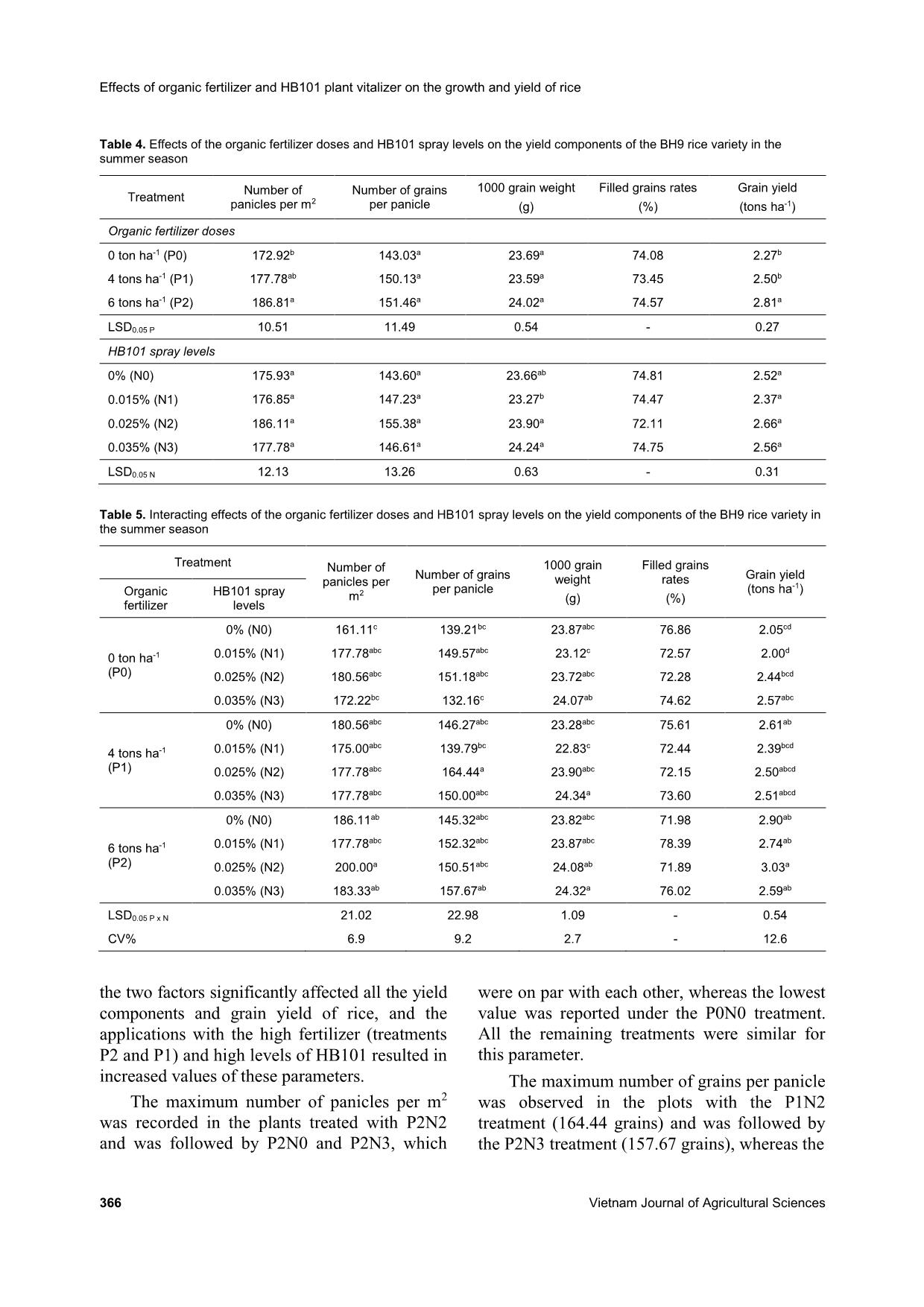
Trang 10
Tải về để xem bản đầy đủ
Tóm tắt nội dung tài liệu: Effects of organic fertilizer and HB101 plant vitalizer on the growth and yield of rice (Oryza sativa L.)
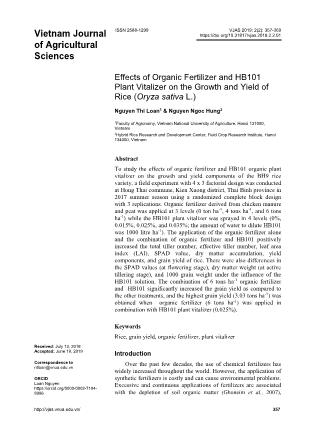
d not affect the number of grains per panicle or the 1000 grain weight. All the parameters were progressively augmented by incremental levels of fertilizer up to the highest dose tested. The P2 treatment significantly increased the mean grain yield (2.82 tons ha-1) as compared to the P1 and P0 treatments, which were on par with each other. In terms of the HB101 solution, this factor did not influence the yield components or grain yield of the rice variety BH9 in the summer season, excepting the 1000 grain weight parameter. However, higher applications of the HB101 solution (N2 and N3 treatments) led to increases in all the parameter values as compared to the N0 and N1 treatments. The interactive effects of the organic fertilizer doses and HB101 spray levels on the yield attributes and grain yield are shown in Table 5. It was reported that the combination of Effects of organic fertilizer and HB101 plant vitalizer on the growth and yield of rice 366 Vietnam Journal of Agricultural Sciences Table 4. Effects of the organic fertilizer doses and HB101 spray levels on the yield components of the BH9 rice variety in the summer season Treatment Number of panicles per m2 Number of grains per panicle 1000 grain weight (g) Filled grains rates (%) Grain yield (tons ha-1) Organic fertilizer doses 0 ton ha-1 (P0) 172.92b 143.03a 23.69a 74.08 2.27b 4 tons ha-1 (P1) 177.78ab 150.13a 23.59a 73.45 2.50b 6 tons ha-1 (P2) 186.81a 151.46a 24.02a 74.57 2.81a LSD0.05 P 10.51 11.49 0.54 - 0.27 HB101 spray levels 0% (N0) 175.93a 143.60a 23.66ab 74.81 2.52a 0.015% (N1) 176.85a 147.23a 23.27b 74.47 2.37a 0.025% (N2) 186.11a 155.38a 23.90a 72.11 2.66a 0.035% (N3) 177.78a 146.61a 24.24a 74.75 2.56a LSD0.05 N 12.13 13.26 0.63 - 0.31 Table 5. Interacting effects of the organic fertilizer doses and HB101 spray levels on the yield components of the BH9 rice variety in the summer season Treatment Number of panicles per m2 Number of grains per panicle 1000 grain weight (g) Filled grains rates (%) Grain yield (tons ha-1) Organic fertilizer HB101 spray levels 0 ton ha-1 (P0) 0% (N0) 161.11c 139.21bc 23.87abc 76.86 2.05cd 0.015% (N1) 177.78abc 149.57abc 23.12c 72.57 2.00d 0.025% (N2) 180.56abc 151.18abc 23.72abc 72.28 2.44bcd 0.035% (N3) 172.22bc 132.16c 24.07ab 74.62 2.57abc 4 tons ha-1 (P1) 0% (N0) 180.56abc 146.27abc 23.28abc 75.61 2.61ab 0.015% (N1) 175.00abc 139.79bc 22.83c 72.44 2.39bcd 0.025% (N2) 177.78abc 164.44a 23.90abc 72.15 2.50abcd 0.035% (N3) 177.78abc 150.00abc 24.34a 73.60 2.51abcd 6 tons ha-1 (P2) 0% (N0) 186.11ab 145.32abc 23.82abc 71.98 2.90ab 0.015% (N1) 177.78abc 152.32abc 23.87abc 78.39 2.74ab 0.025% (N2) 200.00a 150.51abc 24.08ab 71.89 3.03a 0.035% (N3) 183.33ab 157.67ab 24.32a 76.02 2.59ab LSD0.05 P x N 21.02 22.98 1.09 - 0.54 CV% 6.9 9.2 2.7 - 12.6 the two factors significantly affected all the yield components and grain yield of rice, and the applications with the high fertilizer (treatments P2 and P1) and high levels of HB101 resulted in increased values of these parameters. The maximum number of panicles per m2 was recorded in the plants treated with P2N2 and was followed by P2N0 and P2N3, which were on par with each other, whereas the lowest value was reported under the P0N0 treatment. All the remaining treatments were similar for this parameter. The maximum number of grains per panicle was observed in the plots with the P1N2 treatment (164.44 grains) and was followed by the P2N3 treatment (157.67 grains), whereas the Nguyen Thi Loan & Nguyen Ngoc Hung (2019) https://vjas.vnua.edu.vn/ 367 minimum number of grains per panicle was noted in the P0N3 treatment (132.16 grains). In terms of the 1000 grain weight, the P2N3 and P1N3 treatments significantly increased this parameter as compared to the other treatments (24.34g and 24.31g, respectively), however, the values were not significantly different from each other. The lower applications of fertilizer (P0 and P1) with the N1 treatment reported the lowest values of grain weight with 23.12g and 22.83g, respectively. Grain yield of the BH9 rice variety fluctuated from 2.00 tons ha-1 to 3.03 tons ha-1. Under higher doses of fertilizer, the treatments with the HB101 solution gave increased values of grain yield as compared to lower organic fertilizer dose. Application of the P2N2 treatment gave the highest significant increment of the rice yield compared with the other treatments. It was followed by the P2N0, P1N0, and P2N3 treatments with yields of 2.90 tons ha-1, 2.61 tons ha-1 and 2.59 tons ha-1, respectively, and they were on par with each other. The minimum grain yield was recorded in the P0N1 and P0N0 treatments with approximately 2 tons ha-1 each. It seems that the nutrients released from the organic fertilizer play a more important role than the HB101 solution. This is in line with the above observations as the organic fertilizer doses directly affected the formation of grain yield. In previous studies, Bagayoko et al. (2012) and Moe et al. (2017) did not record significant differences in yield and yield components under the applications of different doses and kinds of organic manures. Moe et al. (2017) showed that the application of organic manure alone did not significantly enhance the yield and yield attributes of rice in a cropping season, which can be explained by severe deficiencies in nitrogen at the vegetative stage. Bagayoko et al. (2012) indicated that the manure effects were very heterogeneous and high rates did not necessarily increase crop yields. Ghoneim et al. (2007) recorded increases in grain yield to 34.8% under the application of poultry manure over the control without fertilizer. This was consistent with the findings of Myint et al. (2011) and Dash et al. (2011), who considered that this might be due to the quick release of a number of nutrients like N and P from the organic inputs. In the present study, we observed that the effects of the organic fertilizer application on grain yield and the number of panicles per m2 were significant; and high doses of fertilizer led to increases in grain yield and yield components, which can be explained by the increase in nutrient contents, especially N, from the organic fertilizer. These results are similar to the study of Gautam et al. (2013), who showed that with the increasing levels of fertilizer, grain yield increased significantly and consistently, and achieved the highest increases with the highest fertilizer level (20 tons ha-1). According to the authors, the increase of rice grain yield under the organic manure treatment may have been due to the fact that the slow releasing nutrients from the organic manure over a long period increased the availability of nitrogen and the efficiency of the applied or native soil phosphorus due to the solubilizing effect of organic acids produced during decomposition of organic manures (Srivastava et al., 2016). Siavoshi et al. (2011) explained that the increase in grain yield components was due to the better water holding capacity of the soil as a result of more organic material applications leading to more available water in the soil, which enhanced nutrient availability and improved nutrient absorption as well as increased the production and translocation of the dry matter content. There were no differences among the yield components, potential yield, and grain yield under the effects of the HB101 solution, which may be due to the fact that the HB101 solution works to maintain the proper balance of soil micro-organisms, and its ionized minerals combined with the plant nutrients from the organic fertilizer caused the strengthening of the leaf, stem, and root systems, thereby improving the growth processes and immune function of the plants. These results were similar to the study of Mohammadi et al. (2013) in terms of the effects of the HB101 solution on potato. The authors observed that there was no effect of the HB101 solution on potato yields; however, the Effects of organic fertilizer and HB101 plant vitalizer on the growth and yield of rice 368 Vietnam Journal of Agricultural Sciences combination of HB101 with other fertilizers showed positive effects on the potato traits. Conclusions The results indicated significant increases in the growth and yield of the BH9 rice variety in the summer season under applications of different doses of organic fertilizer and the HB101 plant vitalizer. Organic fertilizer alone and the integration of organic fertilizer and the HB101 solution showed significant effects on the number of total tillers, the number of effective tillers, dry matter weight, LAI values, SPAD values, grain yield, and yield components. In general, high rates of organic fertilizer application and high HB101 spray levels resulted in increases in the growth and yield of rice by increasing the number of tillers, effective tillers, physiological parameters (LAI, SPAD, and dry matter accumulation), grain yield, and all the yield attribute parameters. The P2N2 treatment (6 tons ha-1 of organic fertilizer combined with the HB101 spray level of 0.025%) gave the highest grain yield with 3.03 tons ha-1, which was significantly higher than the rest of the treatments. Besides, the application of the HB101 solution with the organic fertilizer dose of 6 tons ha-1 also showed higher grain yield of the BH9 rice variety in the summer season. Acknowledgements We acknowledge the People’s Committee and the Farmer Association of Hong Thai commune, Kien Xuong district, Thai Binh province, Vietnam for facilitating and supporting the experimental arrangement in the field experiments. References Bagayoko M. (2012). Effect of plant density, organic matter and nitrogen rates on rice yields in the system of rice intensification (SRI) in the “office du Niger” in Mali. ARPN Journal of Agricultural and Biological Science. 7(8): 620-632. Dash D. A., Patro H., Tiwari R. C. & Shahid M. (2011). Effect of organic and inorganic sources of N on growth attributes, grain and straw yield of rice (Oryza sativa). International Journal of Pharmaceutical and Life Sciences. 2(4): 655-660. Erdal I., Turkmen R. & Akgun A. (2016). Variation in chlorophyll, SPAD value and some nutrient concentrations depending on Chlorosis in Peach leaves. Lucrari Stiintifice. 59(2): 13-16. Gafar A. F., Yassin M. I. D. & Samia O. Y. (2014). Effect of different fertilizers (bio, organic and inorganic fertilizers) on some yield components of rice (Oryza Sativa L.). Universal Journal of Agricultural Research. 2(2): 67-70. Gautam P., Sharma G. D., Rana R. & Lal B. (2013). Effect of integrated nutrient management and spacing on growth parameters, nutrient content and productivity of rice under system of rice intensification. International Journal of Research in BioSciences. 2(3): 53-59. Ghoneim A. (2007). Effect of nitrogen supplied from poultry manure and sewage sludge on growth, yield and nitrogen uptake of rice. Bulletin of Experimental Farm, Faculty of Agriculture, Ehime University. 29: 11-16. Islam M. S., Paul N. K., Alam M. R., Uddin M. R., Sarker U. K., Islam M. A. & Park S. U. (2015). Responded of rice to green manure and nitrogen fertilizer application. Online Journal of Biological Science. 15(4): 207-216. Javier E. F., Marquez J. M., Grospe F. S., Mamucod H. F. & Tabien R. E. (2002). Three-year effect of organic fertilizer use on paddy rice. Philippine Journal of Crop Science. 27(2): 11-15. Liu C. W., Sung Y., Chen B. C. & Lai H. Y. (2014). Effects of nitrogen fertilizers on the growth and nitrate content of lettuce (Lactuca Sativa L.). International Journal of Environmental Research and Public Health. 11(4): 4427- 4440. Moe K., Win M. K., Win K. K. & Yamakawa T. (2017). Combined effect of organic manures and inorganic fertilizers on the growth and yield of hybrid rice (Palethwe - 1). American Journal of Plant Sciences. 8: 1022-1042. Mohammadi G. R., Ajirloo R. A., Ghobadi M. E. & Najaphy A. (2013). Effects of non-chemical and chemical fertilizers on potato (Solanum tuberosum L.) yield and quality. Journal of Medicinal Plants Research. 7(1): 36-42. Myint A. K., Yamakawa T., Kajihara Y. & Zenmyo T. (2010). Application of different organic and mineral fertilizers on the growth, yield and nutrient accumulation of rice in Japanese ordinary paddy yield. Science World Journal. 5(2): 47-54. Nguyen Thi Loan & Nguyen Ngoc Hung (2019) https://vjas.vnua.edu.vn/ 369 Myint A. K., Yamakawa T., Zenmyo T., Hoang T. B. T & Sarr P. S. (2011). Effects of organic-manure application on growth, grain yield, and nitrogen, phosphorus, and potassium recoveries of rice variety Manawthuka in paddy soils of differing fertility. Communications in Soil Science and Plant Analysis. 42: 457-474. Ohyama N., Katono M. & Hasegawa T. (1998). Effects of long term application of organic materials to the paddy field originated from Aso volcanic ash on the soil fertility and rice growth. I. Effects on the rice growth and nutrient uptake for the initial three years. Proceeding of Faculty of Agriculture, Kyushu Tokai University. 17: 9-24. Rao T. K., Rao U. A., Sekhar D., Ramu P. S. & Rao V. N. (2014). Effect of different doses of nitrogen on performance of promising varieties of rice in high altitude areas of Andhra Pradesh. International Journal of Farm Sciences. 4(1): 6-15. Siavoshi M., Nasiri A. & Lawre S. (2011). Effect of organic fertilizer on growth and yield in rice (Oryza sativa L.). Journal of Agricultural Science. 3(3): 217- 224. Siddaram M. D., Murali K., Manjunatha B. N., Ramesha Y. M., Basavaraja M. K. & Policepatil A. S. (2010). Effect of nitrogen levels through organic sources on growth, dry matter production and nutrient uptake of irrigated aerobic rice (Oryza sativa L.). International Journal of Agricultural Sciences. 6(2): 426-429. Singh S., Bohra J. S., Singh Y. V., Upadhyay A. K., Verma S. S., Mishra P. K. & Raghuveer M. (2017). Effect of integrated nutrient management on growth and development stages of rice under rice-wheat ecosystem. International Journal of Current Microbiology and Applied Sciences. 6(7): 2032-2042. Srivastava V. K., Singh J. K. & Vishwakarma A. (2016). Effect of fertility levels and mode of nitrogen nutrition n productivity and profitability of hybrid rice under system of rice intensification. International Journal of Agriculture Sciences. 8(47): 1983-1986.
File đính kèm:
 effects_of_organic_fertilizer_and_hb101_plant_vitalizer_on_t.pdf
effects_of_organic_fertilizer_and_hb101_plant_vitalizer_on_t.pdf

